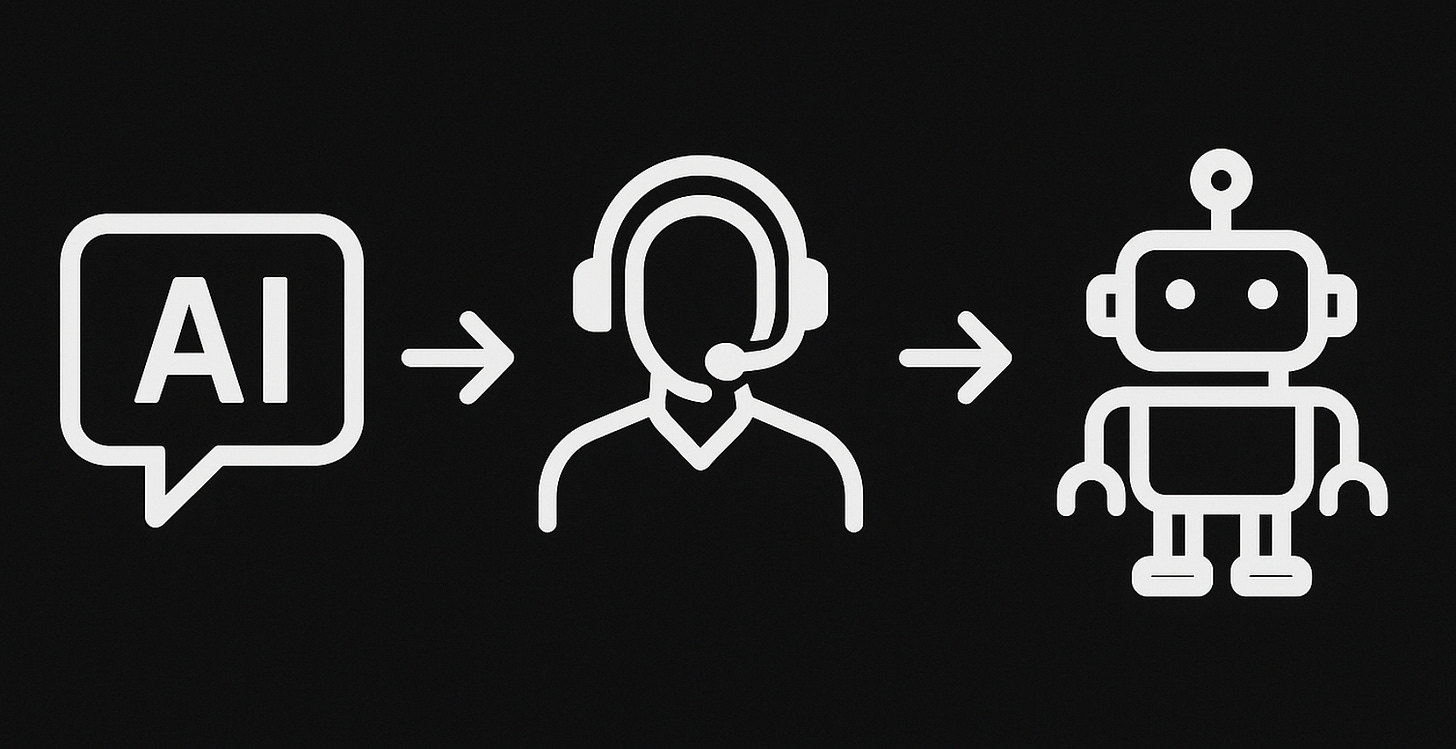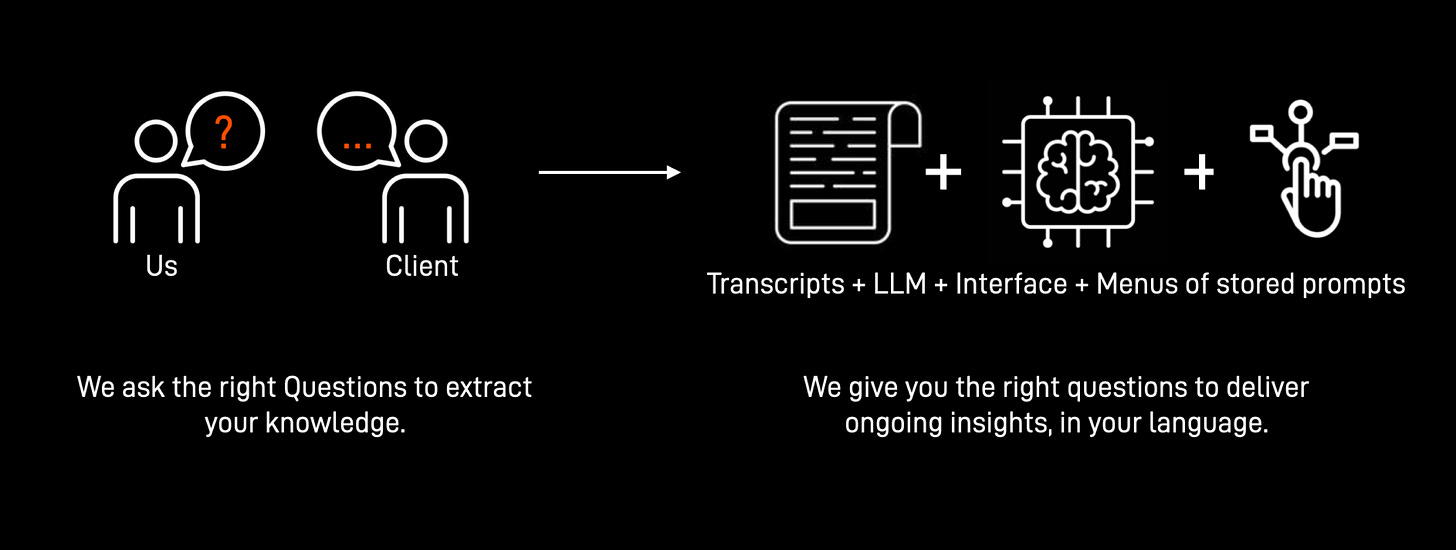AI Knowledge Bases & AI Transformation
Custom knowledge bases as the AI era equivalent of a website and how they lead to opportunities beyond.
Product Design & Insights
In this newsletter I’ll identify new trends outline future scenarios and propose product, business and investment opportunities based on the macro environment of unprecedented societal and technological change. The insights are aimed at an audience of both investors and operators.
We also offer a service where we combine and reframe them around your business and deliver that directly in an AI model with interfaces to extract ongoing value.
That in turn opens up the opportunity for a deeper engagement around AI era business transformation and the design and prototyping of new products and services as an alternative to traditional corporate venturing.
Every Business Will Have a Website.
In the early days of the web I spoke to a potential investor, suggesting that one day all businesses would have a website and there was a business to be made building them. He didn’t believe this - websites were for geeks.
Despite the need for websites being correct, website building businesses became the domain of agencies and integrators, a largely artisanal rather than scaleable activity. Startup opportunities only flourished later, when the introduction of forms into websites meant you could build browser based applications and capture internet network effects to build end user, platform scale businesses around a website that was an application itself.
Every Business Will Have an AI Knowledge Base
A similar thing is happening now with AI. Every organization and many individuals need an AI model augmented with their own internal documentation, a fancy version of uploading documents and chatting about them with an AI chatbot - an AI knowledge base for interrogation by anyone.
The AI knowledge base is the AI era equivalent of the website, the core around which future AI end user use cases will evolve, but much of their delivery will be an artisanal activity unless it is delivered as a true application.
Here I’ll argue that although much of the AI opportunity is upstream in deep tech and infrastructure and that most venture backed startups will be eaten by ‘big AI’ at the front end, downstream, the value add that makes an AI knowledge base an application is not in the back-end software to process documents and create it, but in the processes and interface around it. This is the one AI wrapper business that really matters.
The AI Era is About Asking Great Questions
Most People Have Faced the Alexa Problem, which is not being sure what you can ask it. This problem is an even bigger one with AI and is often overlooked.
Whereas prompt engineering focuses more on how to ask questions (something which itself is becoming obsolete as AI systems self tune prompts) asking great questions in the first place is where much AI era value-add can be created. Great questions are the simplest, atomic-unit of creativity. As AI shifts the focus of human value-add away from execution to ideas, where questions are the entry points for human creativity, a knowledge base application will center around questions packaged as sophisticated menus and interfaces.
From Answers to Online Agents to Real World Automation
AI’s provide answers based on human questions as prompts. As they evolve from providing single answers, to connecting these to actions in the online word (agents) to actions in the real world (from self driving to general purpose robotics), asking questions becomes more about defining use cases and workflows.

These can all be seen as expanding on the core idea of asking the right questions, and a are a creative challenge rather than an engineering one. Even a workflow can be seen as responses to a sequence of the right questions (is the user in need of x - then y).
In the AI world, everything humans do starts to revolve around asking questions rather than providing answers and in the broadest sense, questioning everything is the domain of creatives and designers rather than engineers and surgeons.
Design Rather Than Build
Just as producing a piece of writing can now be based on delivering the right prompt, building a new application will be about instructing an agent with a novel and well defined use case and creating something in the real word will be about specifying a task rather than executing it. This is why creative industries will prosper. An architect specifies what to build, while the contractor builds it; a product designer specifies a use case and functionality while a software engineer codes it and an interviewer asks the right question while a reporter transcribes answers and events.
The future belongs to great interviewers, designers and architects.
What A Design and Analytics AI Agency Will Do
I previously wrote about how I plan to deliver a new type of strategy consulting based on identifying and combining a spectrum of different narratives to derive insights. This was based on my career as a technology entrepreneur and venture capital investor, where my focus was on business models, trend spotting and financial services knowledge.
Now I’ll describe how that consulting business feeds into a new type of creative design agency, with a core product around AI knowledge bases in order for it to scale. This is based on my previous career as a designer, having originally qualified as an architect and then applying that design training to software products and eventually businesses, through systems design.

Tying the Product Design & Insights Opportunity Together
There are three components to what we’ll do at F2N:
1. A newsletter where I identify new trends, future scenarios and product, business and investment opportunities based on the macro environment of societal and technological changes.
2. A consulting service where we (myself and a collaborators) recenter these insights and opportunities around your business and combine with your own, then deliver in a way you can extract your own insights via custom ‘lenses’, for investors, corporates or deep-tech startups.
3. A service where we use 2. as a starting point for AI transformation to optimise internal operations or design and prototype new products.
Over time, the idea is to scale and productise these offerings, de facto, based on solving real needs. In terms of team, the idea is to draw from a pool of highly creative and experienced collaborators on a project by project basis.
1. F2N Insights: AI Era Scenarios Newsletter
Unique Market Insights from a Technology and Investment Perspective
Our analytics business works by identifying market and technology trends which I will outline in this newsletter and synthesising them into insights, investment theses and future scenarios, for funds, startups and corporations. Together with a broad range of collaborators, our (and that is why I say our) unique value proposition is based on me having sat on both sides of the table as both an entrepreneur and investor, working in internet technology since before the web and with a broad network of collaborators on connections to be able to describe current opportunities for deploying resources or capital.
2. F2N Insights: AI Era Business & Investment Strategies
(a) Insights from your Frame of Reference
To do this means conversations with stakeholders and asking the right questions so that our insights are positioned from your own businesses frame of reference and combined with your own insights. In the past this was done by manually capturing that information in formal workshops and meetings which made the process less natural and serendipitous. We have all experienced where real insights come from: the lobby area of a conference, over drinks after a meeting or on a hike. With today’s AI tools, transcriptions and understanding of these types of interaction can be automatic and seamless.
We will orchestrate natural interactions, automatically capture transcripts and embed them in a dedicated AI knowledge base.
This process is already far more efficient than today’s investment analyst or strategy consulting services, but I believe that in future this will become as standard as having a website and will not be where our real value is delivered. Where we deliver value is in our ability to ask the right questions to garner ‘investable insights’ from the external market or your own organization, internally.
(b) Reporting Through Your Lens
Strategy consultants and analysts typically deliver a beautifully presented report, but this has several problems that make it obsolete. Firstly, reports are often created by more junior people with less experience and so key insights can get diluted. Secondly, the report is often a static document with a finite shelf-life that delivers no ongoing value. Lastly, the report delivers information in one format, delivering the same message to an entire audience.
We will deliver custom interfaces with menus of prompts, personas or agents that deliver real-time updated insights from the knowledge base.
Instead of a single static report you get updated information, delivered through your own lens, where that lens can be at a company, department or individual level.
Again, this software and process is not where the real value add lies, which is in the creative process of crafting what questions to ask to extract the best insights and packaging them as interfaces.
3. F2N Design: AI era Transformation & Venture Design
The process of delivering strategy services as a custom interface to transcripts uploaded to an AI model acts as a go to market to deliver more widespread AI era operational practices within an organization - think of this as the AI equivalent of ‘digital transformation’, where AI transformation revolves around more efficient operational practices around the core AI knowledge base, delivered in conjunction with design and prototypes of software tools around it.
In practice, what this looks like is creating tools and processes for automatic transcriptions of conversations and menus of prompts and agents to extract custom reports.
This allows people to work in an environment where they don’t need to write formal documents as all documents are produced on the fly upon interaction with an LLM and where form filling is replaced by asking questions in natural language from unstructured data, where useful questions to ask are selectable from custom menus.
We will help you combine your own information with an LLM, with the assumption that the best way to do this will change over time and eventually commoditize into a standard offering that we will enable.
We will then help you build bespoke menus of the right questions you can ask of your information tailored to individuals and departments.
And from this starting point we can enable an organization to work around the core knowledge base in an environment largely free of documents, forms and excessive bureaucratic process, to become much more human, enjoyable, creative and efficient through a process of AI era transformation.
From this starting point our offering can extend to designing and prototyping new products for internal efficiency or new customers.
As AI makes software development much easier, applications that weren’t previously viable become possible and more and more niche applications can be built, the focus switches to finding creative use cases and knowing how to design and interact with rather than build them.
Winning in this space will not be a small opportunity, and the gap exists for something like an IDEO in terms of creative design meeting McKinsey in terms of intellectual analysis. That’s what I hope to help build at F2N.





Mr Galbraith,
I find your ideas interesting and valuable.
However, I think this newsletter's clarity and brevity could be improved.
If you would be prepared to read it, I will re-write a section to illustrate my thinking.
Kind Regards,
Tim Fidgeon